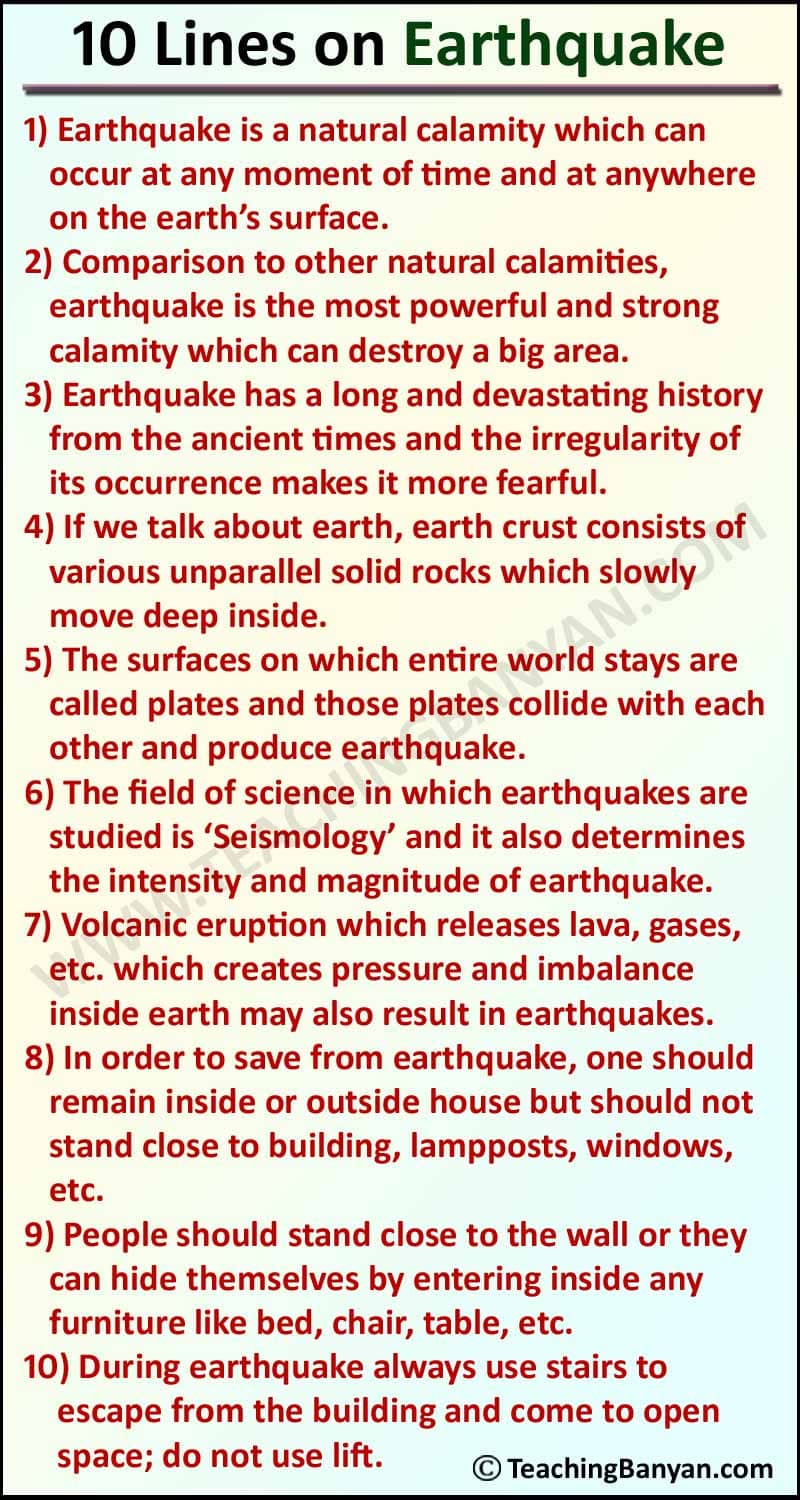An earthquake or sometimes called as quake or tremors is a sudden violent shaking of earth which proves to be very devastating as it collapses the building and destroys whole geographical area.
Earthquake is so strong phenomena that it can take so many lives in one go. Earthquake contrary to other natural calamities like floods and drought is sudden activity which doesn’t give us time to get alert causing maximum causalities at a time.
There is no place in the entire world which is not prone to earthquakes. The range of an earthquake can be mild or can be very extreme which can destroy whole area and can take many lives.
Ten Lines on Earthquake in English
We have provided 10 lines, 5 lines, 20 lines, few lines and sentences on Earthquake in English for Class 1, 2, 3, 4, 5 and 6. You can add these lines in your essays and paragraph writing in your exams as well as in the school competitions. It will also be very helpful to write few lines, some sentences, facts about Earthquake, etc.
10 Lines on Earthquake
1) Earthquake is the shaking movement of the earth’s surface which creates seismic waves.
2) It is a sudden and violent shaking which causes disaster.
3) The shocks we receive in earthquake arise from deep inside the earth.
4) Earthquake can originate at any point of the earth crust and can cause damage.
5) A huge energy is released which crosses through the rocks and comes to earth surface.
6) Magnitude of earthquake originated at a point is measured by Richter’s scale.
7) Intensity of earthquake which has affected the places is measured by Mercalli scale.
8) Generally, the first shock of earthquake is heavy which is called as main shock.
9) After the main shock the tremors which come have low density called as aftershock.
10) Earthquake is very disastrous in nature as it can take millions of lives in one go.
10 Lines and Sentences on Earthquake
1) Earthquake is a natural calamity which can occur at any moment of time and at anywhere on the earth’s surface.
2) Comparison to other natural calamities, earthquake is the most powerful and strong calamity which can destroy a big area.
3) Earthquake has a long and devastating history from the ancient times and the irregularity of its occurrence makes it more fearful.
4) If we talk about earth, earth crust consists of various unparallel solid rocks which slowly move deep inside.
5) The surfaces on which entire world stays are called plates and those plates collide with each other and produce earthquake.
6) The field of science in which earthquakes are studied is ‘seismology’ and it also determines the intensity and magnitude of earthquake.
7) Volcanic eruption which releases lava, gases, etc which creates pressure and imbalance inside earth may also result in earthquakes.
8) In order to save from earthquake, one should remain inside or outside house but should not stand close to building, lampposts, windows, etc.
9) People should stand close to the wall or they can hide themselves by entering inside any furniture like bed, chair, table, etc.
10) During earthquake always use stairs to escape from the building and come to open space; do not use lift.

5 Lines on Earthquake
1) Earthquakes are unequal earth tremors.
2) It is a deadly natural occurrence.
3) Richter scale measures earthquakes.
4) Japan regularly experiences earthquakes.
5) During earthquakes, we should shield our heads and neck.
20 Lines on Earthquake
1) Earthquake is a natural occurrence creating seismic waves and causing the shaking of earth’s surface.
2) The intensity of earthquakes is measured in Richter scale developed by Charles F. Richter.
3) Earthquakes range from low intensity to powerful enough to demolish buildings and kill cause panic.
4) Earthquake with its epicenter beneath sea bed, triggers large destructive waves called Tsunami.
5) Earthquakes are mainly caused by the rupture of geological faults, landslides, mine blasts etc.
6) Point of rupture below the ground which triggers an earthquake is called the focus or hypocenter.
7) Epicenter of an earthquake is the point at the earth surface directly above the hypocenter.
8) Three main types of faults causing earthquakes are – normal, reverse (thrust) and strike slip.
9) Seismometer is the device used to measure the magnitude of an earthquake.
10) Earthquake becomes more destructive when the epicenter is beneath the sea bed.
11) The fastest earthquake wave which arrives first is called the P wave or compressional wave.
12) The deepest earthquakes typically occur at an approximate depth of 750 Km (400 miles).
13) During an earthquake soft ground shakes more than the hard rock, a claim proved by Aristotle.
14) Earthquakes are mainly caused due to shifting masses of rock, miles below the surface of earth.
15) Earthquake waves cannot be heard by humans as they have an inaudible frequency of less than 20Hz.
16) Shaking of ground doesn’t cause loss of life, rather the destruction of manmade structures cause it.
17) Millions of earthquakes occur around the world annually, which are too weak to be recorded.
18) Around 80% of the world’s earthquakes occur along the Pacific Rim called the “Ring of Fire”.
19) Largest earthquake by magnitude 9.5 was recorded in Chile on 22nd May 1960.
20) Alaska is the world’s most seismically active and earthquake prone area with annual earthquakes.
Earthquakes came in to existence since the time earth was created. There are many incidents of earthquakes in the world where the death toll was extremely high. India is also not unaffected of earthquakes, be it Latur in Maharashtra in 1993 or 2001 earthquakes in Bhuj, Gujarat.
In 2015, Nepal received the serious jolts of earthquakes claiming thousands of lives. We must take several measures and make our homes, buildings and cities in a scientific way to protect ourselves from aftermath of earthquake.
